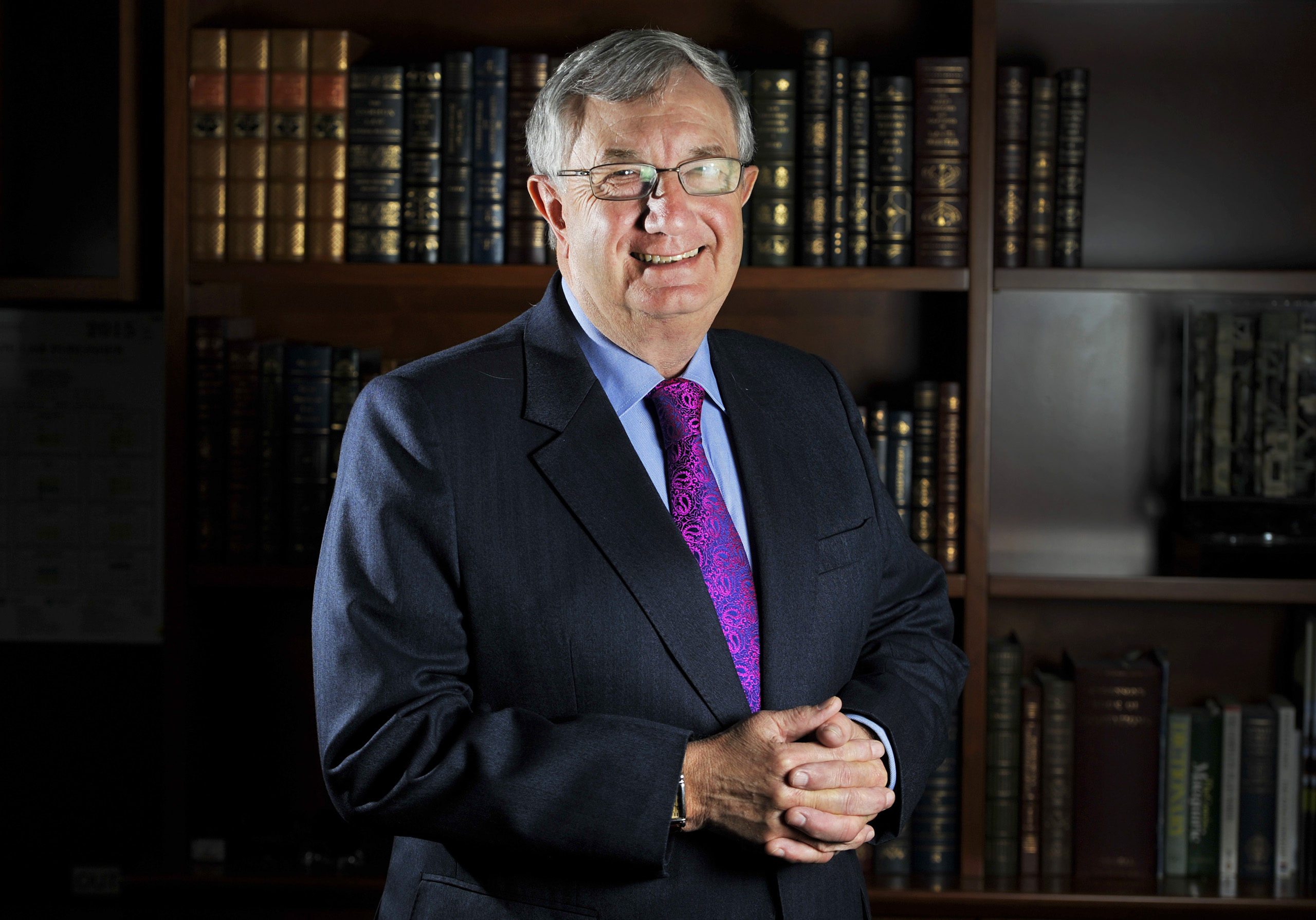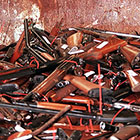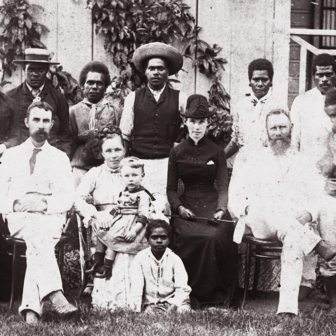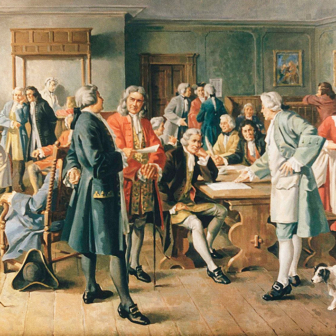When I was a law student in the early nineties, I met a federal prosecutor at a party. I told her that she had my dream job, but that I had one worry: that I’d become hard. “After a while,” I explained, “I’d start to think that all criminal defendants are bastards and all their lawyers are tricksters or worse.” She laughed and told me not to worry. Relieved, I mulled what to ask next: the steps to get where she was? What comes after? But then she added the words that, as much as anything else, started me on my path to academia: “They are all bastards.”
In his new book, John McKechnie, Western Australia’s most important prosecutor in recent decades, describes other ways life’s roads can diverge. On Boxing Day 1975, a car overturned while it was drag-racing through woody roads south of Perth. The following year, McKechnie, just out of articles and working on road accident cases in a law firm, was picked to defend the young driver of the other car. “Although unaware at the time, I was about to embark on a life of crime,” he observes. His argument in court — that the death of a passenger was the fault of the driver of the overturned vehicle alone — scored his client probation and McKechnie a job offer from the trial’s prosecutor. He’d never thought of working as a government lawyer before, but took the job because of the higher pay and increased court time.
The first quarter of My Life in Crime describes many such moments. In 1987, another Perth teen was accused of a roadside killing, this time by beating a taxi driver to death. McKechnie — who had just taken silk and swapped roles with Western Australia’s most senior prosecutor (who would soon become a judge) — was now the prosecutor, but the outcome was again a favourable verdict for the accused and a promotion for McKechnie. The subsequent public outcry about the teen’s speedy parole (including harsh parliamentary criticism of the government’s lawyers) was followed by a promise to create a new independent prosecuting office. Two years later, McKechnie was the state’s first director of public prosecutions.
A decade later, and now in his second term as director, McKechnie stood beside his own overturned car on the Nullarbor and had an epiphany — “plans for an ordered life are fragile” — that led him to renounce his life of crime and become a Supreme Court justice. He U-turned again fifteen years later when, as the state’s senior puisne (second-most-senior) judge, he was tasked with convincing one of his colleagues to head Western Australia’s troubled anti-corruption commission. No one was interested, but more than one told McKechnie: “if the job was so good, why didn’t you take it?’ His response was to take the job, which he has held for most of the last decade (retiring last month.)
If McKechnie’s road to three of the most powerful criminal justice roles in the West — head prosecutor, senior judge and corruption czar — seems to unfold almost accidentally, that’s partly because legal jobs like these can be a pipeline. All but one of Western Australia’s directors of public prosecutions became judges. All of the state’s corruption bosses were once judges. Something similar happens across Australia.
But it’s also because McKechnie, on his own account, lacks a broader ambition. Consider his most consequential decision as a prosecutor: to charge two Perth doctors with performing an abortion. “Light blue touch paper and retire to a safe distance,” he recalls telling his colleagues. The charges sparked an outcry that prompted the partial decriminalisation of abortion in Western Australia, with its parliament enacting a model that has since been followed in much of Australia. To paraphrase Lincoln, one way to get rid of a bad law is to apply it.
But McKechnie denies any reformist goal, insisting he simply worked through a list of factors in his office’s prosecution policy. Reasonable prospect of conviction? Check. Law obsolete? No. Public opinion? Divided. And, after the firestorm — pickets, petitions and, finally, parliament — “I waited a decent interval for the dust to settle and announced that, in view of the change in the law, it was no longer in the public interest to proceed.”
He repeats the words of one of the doctors’ defence lawyers, Ron Cannon, who always told his own clients: “I fight cases, not causes.” “Having searched my conscience,” he concludes, “I am content that my decision was made within the legal framework that governs all prosecutions.”
So, what does drive John McKechnie? Stories. He grew up listening to tales his father invented. He chose law over medicine because “I found the prospect of listening to stories more appealing than memorising the scientific names for the parts of a body.” In law school, “I was immediately attracted to the stories that lay behind the turgid prose of the judgments.”
I can relate. The same things led to my own life of (teaching and researching) crime. And it’s also what led McKechnie to write A Life in Crime. The book’s introduction explains that he has long put his love of stories into practice by writing short summaries of the facts of quirky legal cases, initially “for my own amusement” but also eventually for fellow lawyers. When he proposed publishing a collection, his friends pointed out a problem: there were almost no criminal cases on the list. McKechnie objected that “there was little of amusement in lives upended.” Eventually, he had his arm twisted.
The result is a book in three parts — McKechnie’s life story, his quirky legal cases and — in the lengthy middle — his accounts of criminal cases he was involved in. It is that middle bit, covering “Criminal cases that changed the law” and a “tapestry” of others “chosen almost at random to illustrate the diversity of law,” that interests me the most.
There’s something there for everyone. Well, for many. For Western Australians, the book dives into the WA Inc. scandal that dominated the state in the 1990s. For law students, there are the backstories to some of McKechnie’s cases that changed national law, such as a dispute over redeveloping the Swan Brewery and a drink-driving appeal, each of which made it harder for governments to break their own laws.
For lawyers, there are sad moments like the prosecution of Lionel Murphy, when McKechnie was dispatched to offer support to the beleaguered judge before Murphy’s own High Court. And his accounts of high-end legal life, including the judges’ anti-climactic remark that often heralds a prosecution win in the national court: “We do not need to trouble you, Mr McKechnie.” (That is, the accused’s pitch was too weak to bother hearing the state’s response.)
For me, it’s the details in McKechnie’s stories. He explains how the abortion case that changed Australian law started with a child telling his show-and-tell class: “we have a dead baby in the fridge.” (The doctors had accommodated the mother’s cultural request.) How the alleged drunk driver in Australia’s key ruling on illegally obtained evidence was none other than Charles Bunning, making that case the hardware mogul’s other nationwide export. How no one in that High Court hearing would say Lionel Murphy’s name, reminding McKechnie of prosecuting cases involving deceased Indigenous people: “it was as if Justice Murphy — who was then a judge of the same High Court — was a phantom.” “No one wanted us there,” he candidly admits of his own role in that hearing, but the result was a friendship with Mary Gaudron, representing New South Wales and later the first woman on the High Court.
But I started to notice some details McKechnie left out. In the abortion case, he briefly describes what some hospitals did after he lit “the blue touch paper”: “Doctors at the main maternity hospital threatened to refuse to undertake termination procedures unless the law was clarified.” But he doesn’t mention a claim made in the press at the time: that two women presented to Perth hospitals with injuries doctors suspected were from trying to perform their own abortions. I wonder why McKechnie omitted that significant detail. Was the claim wrong or the matter more complex? Did he think it too macabre or intrusive? Or did he fear that readers might judge that his actions contributed to those injuries?
My concerns grew with “The Yellow Rose of Texas,” a classic McKechnie yarn about a twelve-kilogram gold nugget a fossicker supposedly found while camping near Kalgoorlie, which a passing US sailor named after an American folk song about a woman who slept with a general to distract him from an invasion. “These origin stories have one thing in common,” McKechnie writes. “They are both false.” There’s no contemporary account of the woman and, as for the gold nugget, it was a fake cast from a smaller amount of gold by three brothers (who also faked the fossicker — their mother in a wig — and even the US sailor). The brothers’ scheme was undercut when an even larger (and genuine) nugget stole the limelight and then fell apart completely when a police search “in an unrelated matter” uncovered a checklist for the “elegant swindle.”
Like most of McKechnie’s stories, this one ends with the brothers (and mother) convicted and losing their appeals, and a neat conclusion: “the Yellow Rose of Texas nugget did not hurt anyone much, except Alan Bond’s pocketbook.” The then entrepreneur (the subject of his own chapter in McKechnie’s book) had snapped up the over-priced nugget.
But that “unrelated matter” McKechnie mentions in passing was anything but neat. It was another kooky, but much bigger and costlier swindle, where Perth’s mint exchanged forty-nine gold bars weighing sixty-nine kilograms for three fake bank cheques. The same three brothers were initially convicted, only for the prosecution’s case to collapse in excruciatingly slow motion: Brian Mickelberg’s conviction was overturned after nine months but Raymond and Peter Mickelberg’s survived for twenty-one years. Western Australia’s courts rejected appeal after appeal before belatedly conceding the real possibility that key police evidence — Raymond’s fingerprint on a cheque and Peter’s supposed confession — were as fake as that gold nugget. The theft from the mint remains unsolved to this day.
None of this is a secret. The case is justifiably (in)famous. So, why isn’t it in McKechnie’s Life in Crime? After all, it changed the law, notably when McKechnie convinced the High Court to reaffirm controversial rulings that barred the national court from receiving “fresh evidence” of innocence (in this case, a new photograph of one of the cheques that contradicted police claims about the fingerprint evidence). And it was full of quirks: my favourite involves McKechnie successfully fending off one of the Mickelbergs’ many appeals against their convictions.
Peter Mickelberg, who had supposedly confessed to his role to two police officers, had found a witness who testified hearing one of the cops say: “Mate, we did a mighty job on those cunts. We stitched them up properly. When he” — the other cop, Don Hancock, later head of the police’s homicide unit — “fixes a brief it stays fixed.” The Court of Appeal didn’t credit the witness but hilariously added that the cop’s alleged remarks “go no further than to suggest that the police in general and Hancock in particular had done a thorough job in preparing the brief for the prosecution of the Mickelbergs.” (The brothers’ belated acquittal followed the cop’s belated confession that he framed the brothers, which in turn followed Hancock’s death in a car bombing.)
Perhaps I am being too hard on McKechnie for leaving out such details. The twists in the Perth Mint case are byzantine, and the law reports include a number of defamation cases about the events. McKechnie (or his publisher) may have decided to drop these particular stitches from his tapestry of cases for any number of reasons. But I can’t be as generous about a further story that is entirely absent from My Life in Crime. Indeed, I was so shocked to see it missing that I got hold of an electronic copy just to confirm that the book omits a word that is perhaps the saddest in Western Australian criminal justice. That word is Mallard.
“Although I couch it as advice, it was effectively my decision,” Justice John McKechnie said in 2007. He was halfway through his time on Western Australia’s Supreme Court, was giving evidence before the body he would eventually run (the state’s Corruption and Crime Commission) and was speaking about the office he previously held (the state’s director of public prosecutions). But this too-perfect meeting point of all of his roles appears nowhere in My Life in Crime.
McKechnie was describing how police had asked him in July 1994 if they could charge Andrew Mallard for the murder of Pamela Lawrence in her Perth jewellery store two months earlier. Mallard was the police’s only suspect. He had been released from detention just before the killing, he had stolen a bicycle in the same suburb the day before the murder, and he couldn’t give a coherent alibi. McKechnie said he watched a video of the homeless, mentally ill man describing in the third person what “the killer would have done” to Lawrence, a story the police claimed contained a dozen details that only the real murderer could have known. McKechnie advised the cops that the strange confession and the lack of forensic evidence posed a challenge, but the prosecution was doable. He was right. The next year, Mallard was convicted of Lawrence’s murder.
And yet Mallard had nothing to do with Lawrence’s death, a stark tragedy that is compounded by many shocking details. McKechnie testified that he was shocked to learn, years too late, that the police in 1994 already had good reason to think Lawrence’s distinctive head wounds could not have been caused by the wrench Mallard described in detail as the murder weapon. He was surely more shocked in 2005 when — after the High Court ordered a retrial, which the state declined to pursue — the police belatedly linked a palm print from the jewellery store’s counter to a man serving time for a murder from the same period, and whose victim had the same distinctive injuries as Lawrence’s. He must have been horrified when that man died of self-inflicted injuries shortly after the media named him as a new suspect in Lawrence’s death. And, presumably, while chair of the commission he once testified before, McKechnie would have been devastated with the news that Mallard’s own road had ended in a hit-and-run in Los Angeles, where the innocent man had started life afresh.
The commission exonerated the then judge of any wrongdoing; his advice to the police wasn’t necessarily wrong and, anyway, bad advice is no crime. But readers of My Life in Crime, if they know of these events at all, are left to guess what McKechnie now thinks of them. Contrast another judge, Michael Kirby, who played a proud role in this case, being one of High Court panel who quashed Mallard’s conviction after Western Australia’s judges somehow didn’t. And yet Kirby repeatedly talks about an earlier role he played in Mallard’s case, as part of a different panel of High Court judges that refused to hear his first appeal in 1997. “Maybe if I’d paid a bit more attention, maybe if I’d seen some of these arguments,” Kirby told university students in 2012, “he wouldn’t have had to spend a decade in prison; it’s something that troubles the mind.” He’s said similar things repeatedly.
What Kirby missed in that earlier case was a chance to throw out Mallard’s videotaped account of Lawrence’s death on the ground that police had not taped multiple earlier interviews with the man while he shuttled in and out of mental health treatment. In rejecting Mallard’s argument, Kirby was clearly influenced by police claims (totally wrong in hindsight) that the account included details only the killer could know (details that he may well have learnt in those untaped interviews).
Another justice, Michael McHugh (who had represented Lindy Chamberlain before the High Court) went even further, declaring that “no reasonable person could come to any other conclusion that [sic] the accused was making admissions.” And a third, the late John Toohey, bore the burden of speaking the words that, as much as any, destroyed Andrew Mallard’s life: “The court need not trouble you, Mr McKechnie.”
In its haste, the nation’s highest court spared McKechnie a speaking role in its initial failure to free an innocent man, which added eight years to his wrongful imprisonment. But the justices would have relied on his written submissions, co-authored with Mallard’s trial prosecutor (who the commission later found had misconducted himself before and during the trial.) And McKechnie must have played a larger role when he represented the prosecution at Mallard’s earlier state appeal. By the mid-nineties, Western Australia’s Supreme Court had tired of the state government’s refusal to follow the rest of Australia in requiring police to record all of their interviews with suspects and had ruled that judges may well reject admissions like Mallard’s in future. Alas, McKechnie’s advocacy seemingly convinced the state’s judges to make one last exception: for Mallard’s own case.
None of this is to say that John McKechnie’s actions determined Andrew Mallard’s fate. The blame falls much more on others, notably the police who investigated the innocent man and sat on evidence casting doubt on his guilt, not to mention the many politicians and judges who failed to safeguard the state’s criminal justice system. McKechnie’s secondary role in this tragedy resembles that of, well, the driver of the other car in a fatal drag race.
No one who reads My Life in Crime will doubt McKechnie’s compassion. He speaks movingly of the horrors of domestic violence, noting that such cases bookended his career (his first trial as a prosecutor, his last as a judge). He clearly has a passion to stop the scourge of corruption, although his book has less to say about police corruption. “Overall,” he writes, “police officers are professional. Complaints are generally dealt with satisfactorily within the agency. Only occasionally has it been necessary for the [Corruption and Crime Commission] to take over and investigate.” His examples of police failings omit the frauds and non-disclosures epitomised in the Mickelberg and Mallard cases.
Nearly all of the stories that make up this tapestry evoke compassion towards the many people touched by the justice system. Civil litigants. People he represented in his initial career as a defence lawyer. Crime victims. Witnesses. Family members. But there is one thread largely missing: compassion for the people he prosecuted. The murderers. The frauds. The fools. The ones who were victims themselves. Even the innocent. Surely, they weren’t all bastards? •
My Life in Crime: A Tapestry of Cases
by John McKechnie | Upswell | $32.99 | 368 pages




